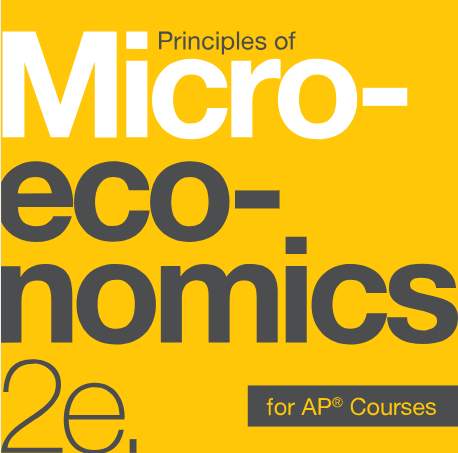
Principles of Microeconomics 2e for AP® – Enhanced with Econblox Videos
The comprehensive contents from this book, combined with Odigia’s teaching and learning tools, and the professionally produced Econblox© Video Series, has everything you need to engage, collaborate, track, and assess your students.
This course includes:

170 +
Econblox Videos

341
practice questions

45
engagement activities

1341
assessment questions
Helping Teachers Do What They Do Best: Teach

Customize
Use our courses as is or easily customize them to fit your teaching style and the needs of your students. You can add your favorite resources, hide and show our existing content and pre-built assessments, or make them your own. Everything your students need, in one place!

Engage and Collaborate
Odigia combines learning materials, discussions, and tools to create a familiar social experience for students allowing you to easily connect and redirect students attention.

Track
See how much time students are spending on different areas of the course, which areas are creating the most amount of engagement and identify topics the students are struggling with. Flag and provide feedback on assignments to proactively meet individual students' needs.

Assess
Game theory allows students to monitor their progress visually and motivates them to stay on track. Students can see exactly what activities they need to complete, which ones have been flagged and compare their progress against the overall class.
Principles of Microeconomics 2e for AP® Course Outline
What is economics?
- Why is economics important?
- What are the differences between microeconomics and macroeconomics?
- How can economists use theories and models to understand economic issues?
- How are economies organized?
- Includes the following Econblox videos:
- How to Plot a Line
- Measuring Slopes
- Different Types of Slopes
- Intersection of Two Lines
- Curved Line: Slopes and Tangents
- Dividing by Fractions
- Compound Interest
- Present and Future Values of Money
- Calculating the Roof Costs Using Present Values
- Rational Economic Exchange
- Circular Flow of Income
How does scarcity affect economies?
- How should individuals make choices based on budget constraints?
- How does production possibilities frontier influence social choices?
- What are the major objections to economic approaches to decision making?
- Includes the following Econblox videos:
- Opportunity Cost Versus Choice
- Definition of Economics and Opportunity Cost
- Corporate Spending Choices
- Government Spending Choices
- Production Possibility Curve
- Production Possibilities Frontier
- Selfish vs. Self-Interest
- Characteristics of Proposals
Why is the relationship between supply and demand important?
- How does demand and supply affect markets for goods and services?
- How does demand and supply shift for goods and services?
- How are changes in equilibrium price and quantity a four-step process?
- What are price ceilings and price floors?
- How does demand and supply relate to efficiency?.
- Includes the following Econblox videos:
- Compilation – Demand Curve
- Movement Along the Demand Curve – Quantity Demanded Decrease
- Movement Along the Demand Curve – Quantity Demanded Increase
- Law of Demand
- Change in Demand – Increase
- Change in Demand – Decrease
- Compilation – Supply Curve
- Moving Along the Supply Curve
- Law of Supply
- Increase in Supply
- Decrease in Supply
- Increase or Decrease in Demand
- Number of Buyers Increases Demand
- Expectations Can Shift Demand
- Variables Shift Supply Curves – Input Prices
- Variables Shift Supply Curves – Technology
- Giffen Goods: Main Video
- Giffen Goods: Key Concept
- Compilation – Market Equilibrium
- Price As Control
- Increase or Decrease in Demand
- Increase or Decrease in Supply
- Demand Increase, Supply Increase
- Demand Decrease, Supply Decrease
- Demand Decrease, Supply Increase
- Demand Increase, Supply Decrease
- Opportunity Cost – Green Space
- Price Controls
- Price Floor
- Disequilibrium Pricing: Main Video
- Disequilibrium Pricing: Key Concept
- Producer Surplus Consumer Surplus
- Consumer Surplus, Producer Surplus
- Consumer Surplus – Western Omelet
- Price Discrimination: Main Video
- Price Discrimination: Key Concept
- Price Discrimination – Elasticity: Main Video
- Price Discrimination – Elasticity: Key Concept
What factors affect the labor and financial markets?
- How does work in labor markets influence demand and supply?
- Who are the demanders and suppliers in a financial market?
- How does the market system serve as an efficient mechanism for information?
What is elasticity?
- How is the price elasticities of demand and supply calculated?
- What are polar cases of elasticity?
- How does elasticity affect pricing?
- What are other areas affected by elasticity?
- Includes the following Econblox videos:
- Price Elasticity
- Elastic Goods
- Inelastic Goods
- Unit Elastic Goods
- Compilation – Price Elasticity of Supply
- Perfectly Inelastic Supply
- Inelastic Supply
- Unit Elastic Supply
- Elastic Supply
- Perfectly Elastic Supply
- Tax Incidence
- How Taxes Affect Supply and Demand
- Tax and Elasticity of Demand, Perfectly Inelastic Demand
- Tax and Elasticity of Demand, Perfectly Elastic Demand
- Tax and Elasticity of Supply, Perfectly Elastic Supply
- Tax and Elasticity of Supply, Perfectly Inelastic Supply
- Tax That Affects Both Buyers and Sellers
- Three Types of Elasticity
- Income Elasticity of Demand
- Income Elasticity – Normal Goods
- Income Elasticity – Necessary Goods
- Income Elasticity – Luxury Goods
- Income Elasticity – Inferior Goods
- Income Elasticity of Demand
- Cross-Price Elasticity of Demand
- Cross-Price Elasticity & Substitute Goods
- Cross-Price Elasticity & Complementary Goods
How do consumers make choices?
- What are consumption choices?
- How can changes in income and prices affect consumption choices?
- What are labor-leisure choices?
- How do intertemporal affect financial capital markets?
- Includes the following Econblox videos:
- Diminishing Marginal Utility: Main Video
- Diminishing Marginal Utility: Key Concept
- Diminishing Marginal Utility Thanksgiving Dinner
- Diminishing Marginal Utility Food and Clothes
- Diminishing Marginal Utility: Key Concept
How does cost affect industry structure?
- How does explicit and implicit costs affect accounting and economic profit?
- How is the structure of costs designed for the short run?
- How is the structure of costs designed for the long run?
- Includes the following Econblox videos:
- Costs of Production
- Total Cost Definition
- Average Costs and Returns to Scale
- Marginal Product
- Production Curve
- Diminishing Marginal Product
- Marginal Cost and Average Fixed Cost
- Marginal Cost Definition
- Marginal Cost Example
- Average Fixed Cost
- Declining Average Cost: Main Video
- Declining Average Cost: Key Concept
What makes perfect competition?
- Why does perfect competition matters?
- How does perfectly competitive firms make output decisions?
- How are entry and exit decisions made for the long run?
- Why is efficiency important in perfectly competitive markets?
- Includes the following Econblox videos:
- Four Market Structures
- Oligopoly Example – Home Improvement Market
- Four Market Structures
- Market Structures – Market Power
- Market Structures Entry Barriers
- Characteristics of the Four Market Structures
- Four Markets Characteristics
- Perfect Competition Characteristics
- Perfect Competition – Introduction
- Perfect Competition – Four Scenario Introduction
- Long-Run Equibrium
- Perfect Competition – Profit Scenario
- Pig Farm Cost Summary
- Profit Scenario Break-even Point
- Profit Scenario Graphs
- Profit Scenario
- Perfect Competition: Loss Scenario No Shutdown
- Pig Farm Cost Summary
- Loss Scenario – No Shutdown
- Loss Scenario Graphs
- Shutdown Scenario
- How Price Affects the Firm’s Decision in Perfect Competition
- Loss Scenario – Shutdown
- Market Supply and Demand Curves
- Market Supply and Demand
- Market Demand Curve in Perfect Competition
What is a monopoly?
- How are monopolies formed?
- How does a profit-maximizing monopoly choose outputs and prices?
- Includes the following Econblox videos:
- An Introduction to Monopoly
- Monopoly Definition
- Market Structures – Monopoly
- Natural Monopoly Low Average Cost
- Natural Monopoly Definition
- Natural Monopoly Google & Utilities
- Natural Monopoly
What is the difference between monopolistic competition and oligopoly?
- What is monopolistic competition?
- What is oligopoly?
- Includes the following Econblox videos:
- Visiting Chick-Fil-A – Monopolistic Competition
- Introduction to Monopolistic Competition
- Monopolistic Competition Definition
- Short-Run Profits
- Ebb and Flow of Monopolistic Competition
- Monopolistic Competition – Market Growth
- Dynamics of Monopolistic Competition
- Monopolistic Competition – Equilibrium
- Short-Run Profit Cost Curves
- Price Collusion
- Oligopoly Introduction
- Oligopoly Definition
- Oligopoly Features
- Regulation and the U.S. Airline Industry
How does monopoly relate to the antitrust policy?
- What are corporate mergers?
- How is anticompetitive behavior regulated?
- How are natural monopolies regulated?
- What is the great deregulation experiment?
- Includes the following Econblox videos:
- Oligopoly – Airlines Versus OPEC
- How Collusion Affects Price
- OPEC Versus Airline Industry
How does environmental protection relate to negative externalities?
- What are the economics of pollution?
- What is command-and-control regulation?
- What are examples of market-oriented environmental tools?
- What are the benefits and costs of U.S. environmental laws?
- What are examples of international environmental issues?
- What is the tradeoff between economic output and environmental protection?
- Includes the following Econblox videos:
- Negative Externalities in Production
What are the positive externalities in public goods?
- Why does the private sector under invests in innovation?
- How can governments encourage innovation?
- What are public goods?
- Includes the following Econblox videos:
- Public Goods
- Differences Between Public and Private Goods
- Free Rider Problem
What are the problems with poverty and economic inequality?
- Where is the poverty line drawn?
- What is the poverty trap?
- What is the safety net?
- What are the measurements and causes of income inequality?
- How do government policies help reduce income inequality?
Why are unions, discrimination, and immigration issues in the labor markets?
- What is the Theory of Labor Markets?
- What role do Wages and Employment play in an Imperfectly Competitive Market?
- What are unions?
- What is a bilateral Monopoly?
- How does employment discrimination happen?
- Why does immigration matter?
- Includes the following Econblox videos:
- The Firm’s Hiring Decision
- Marginal Product
- Marginal Product Definition
- Marginal Revenue Product Definition
- Marginal Product and Hiring
- Why Wages Vary
- Compensating Wage Differential
- Compensating Wage Differential
How does information and risk relate to insurance?
- What is the problem with imperfect information and asymmetric information?
- Why does insurance have imperfect information?
What role does financial markets play in society?
- How do businesses raise financial capital?
- How do households supply financial capital?
- How is personal wealth accumulated?
What is public economy?
- How does voter participation affect costs of elections?
- What are special interest politics?
- What are flaws in the democratic system of government?
What is international trade?
- What is the difference between absolute and comparative advantage?
- What happens when a country has an absolute advantage in all goods?
- How does intra-industry trade happen between similar economies?
- What are the benefits of reducing barriers to international trade?
- Includes the following Econblox videos:
- Production Possibility Frontier Curve
- Production Possibilities Frontier
- Opportunity Cost in International Trade
- Production Possibilities Frontier
- Benefits of International Trade
- How Comparative Advantage is Calculated
- Autarky vs. Specialization
- Comparative Advantage: Main Video
- Comparative Advantage: Key Concept
How does globalization relate to protectionism?
- How is protectionism an indirect subsidy for consumers and producers?
- How does international trade affect jobs, wages, and working conditions?
- What are supporting arguments for restricting imports?
- How is the trade policy enacted globally, regionally, and nationally?
- What are types of trade-offs of the trade policy?
Appendix A: The Use of Mathematics in Principles of Economics
Appendix B: Indifference Curves
- Includes the following Econblox videos:
- Indifference Curves
- Indifference Curves Summary
- How to Plot Indifference Curves
Professionally-produced Econblox Videos
175 short Econblox videos supercharge The Principles of Microeconomics 2e for AP course, energizing students with the theory and practical application of introductory economics. It’s simple to use these mobile-optimized, HD videos, animations and quizzes. Already embedded in the course, these essential visual learning tools improve student preparation and will make them smile. Responsive multiple-choice quizzes make it easy to measure progress. Closed-captioned videos improve student accessibility.
About the creators:
Producers
Contributing Economists
The second edition was developed with significant feedback from current users. In nearly all chapters, it follows the same basic structure of the first edition. General descriptions of the edits are provided in the preface, and a chapter-by-chapter transition guide is available for instructors.
About the authors:
Senior Contributing Authors
Steven A. Greenlaw, University of Mary Washington
David Shapiro, Pennsylvania State University
Contributing Authors
Ralph Sonenshine, American University
Eric Dodge, Hanover College
Cynthia Gamez, University of Texas at El Paso
Andres Jauregui, Columbus State University
Diane Keenan, Cerritos College
Dan MacDonald, California State University, San Bernardino
Amyaz Moledina, The College of Wooster



